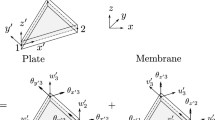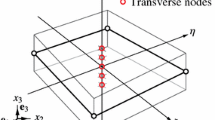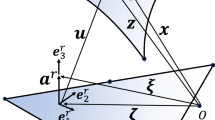Abstract
This paper proposes a new shell element formulation using the scaled boundary finite element (SBFE) method. A shell element is treated as a three-dimensional continuum. Its bottom surface is approximated with a quadrilateral spectral element and the shell geometry is represented through normal scaling of the bottom surface. Neumann expansion is applied to approximate the inversions of the matrix polynomials of the thickness coordinate ξ, including the Jacobian matrix and the coefficient of the second-order term in the SBFE equation. This permits the solution along the thickness to be expressed as a matrix exponential function whose exponent is a high-order matrix polynomial of ξ. After introducing the boundary conditions on the top and bottom surfaces and evaluating the resulting matrix exponential via Padé expansion, we derive the element stiffness and mass matrices. Poisson thickness locking is avoided fundamentally. Numerical examples demonstrate the applicability and efficiency of the formulation.












Similar content being viewed by others
References
Ahmad S, Irons BM, Zienkiewicz OC (1970) Analysis of thick and thin shell structures by curved finite elements. Int J Numer Methods Eng 2:419–451
Belytschko T, Stolarski H, Liu WK, Carpenter N, Ong JSJ (1985) Stress projection for membrane and shear locking in shell finite elements. Comput Methods Appl Mech Eng 51:221–258
Bathe KJ, Dvorkin EN (1986) A formulation of general shell elements—the use of mixed interpolation of tensorial components. Int J Numer Methods Eng 22:697–722
Belytschko T, Wong BL, Stolarski H (1989) Assumed strain stabilization procedure for the 9-node Lagrange shell element. Int J Numer Methods Eng 28:385–414
Bathe KJ, Iosilevich A, Chapelle D (2000) An evaluation of the MITC shell elements. Comput Struct 75:1–30
Bletzinger KU, Bischoff M, Ramm E (2000) A unified approach for shear-locking-free triangular and rectangular shell finite elements. Comput Struct 75:321–334
Koschnick F, Bischoff M, Camprubí N, Bletzinger KU (2005) The discrete strain gap method and membrane locking. Comput Methods Appl Mech Eng 194:2444–2463
Ko Y, Lee PS, Bathe KJ (2017) A new 4-node MITC element for analysis of two-dimensional solids and its formulation in a shell element. Comput Struct 192:34–49
Ko Y, Lee Y, Lee PS, Bathe KJ (2017) Performance of the MITC3+ and MITC4+ shell elements in widely-used benchmark problems. Comput Struct 193:187–206
Kiendl J, Marino E, De Lorenzis L (2017) Isogeometric collocation for the Reissner-Mindlin shell problem. Comput Methods Appl Mech Eng 325:645–665
Bischoff M, Ramm E (1997) Shear deformable shell elements for large strains and rotations. Int J Numer Methods Eng 40:4427–4449
Kim DN, Bathe KJ (2008) A 4-node 3D-shell element to model shell surface tractions and incompressible behavior. Comput Struct 86:2027–2041
Echter R, Oesterle B, Bischoff M (2013) A hierarchic family of isogeometric shell finite elements. Comput Methods Appl Mech Eng 254:170–180
Payette GS, Reddy JN (2014) A seven-parameter spectral/hp finite element formulation for isotropic, laminated composite and functionally graded shell structures. Comput Methods Appl Mech Eng 278:664–704
Carrera E, Brischetto S, Cinefra M, Soave M (2011) Effects of thickness stretching in functionally graded plates and shells. Compos Part B: Eng 42:123–133
Parisch H (1995) A continuum-based shell theory for non-linear applications. Int J Numer Methods Eng 38:1855–1883
Hauptmann R, Schweizerhof K (1998) A systematic development of ‘solid-shell’ element formulations for linear and non-linear analyses employing only displacement degrees of freedom. Int J Numer Methods Eng 42:49–69
Hauptmann R, Doll S, Harnau M, Schweizerhof K (2001) ’Solid-shell’ elements with linear and quadratic shape functions at large deformations with nearly incompressible materials. Comput Struct 79:1671–1685
Li Q, Liu Y, Zhang Z, Zhong W (2015) A new reduced integration solid-shell element based on EAS and ANS with hourglass stabilization. Int J Numer Methods Eng 104:805–826
Mostafa M (2016) An improved solid-shell element based on ANS and EAS concepts. Int J Numer Methods Eng 108:1362–1380
Chapelle D, Ferent A, Bathe KJ (2004) 3D-shell elements and their underlying mathematical model. Math Models Methods Appl Sci 14:105–142
Nguyen KD, Nguyen-Xuan H (2015) An isogeometric finite element approach for three-dimensional static and dynamic analysis of functionally graded material plate structures. Compos Struct 132:423–439
Simo JC, Rifai MS (1990) A class of mixed assumed strain methods and the method of incompatible modes. Int J Numer Methods Eng 29:1595–1638
Zienkiewicz OC, Taylor RL, Too JM (1971) Reduced integration technique in general analysis of plates and shells. Int J Numer Methods Eng 3:275–290
Hughes TJR, Cohen M, Haroun M (1978) Reduced and selective integration techniques in the finite element analysis of plates. Nucl Eng Des 46:203–222
Hughes TJR, Tezduyar TE (1981) Finite elements based upon Mindlin plate theory with particular reference to the four-node bilinear isoparametric element. J Appl Mech 48:587–596
Fish J, Guttal R (1995) Recent advances in the p-version of the finite element method for shells. Comput Syst Eng 6:195–211
Suri M (1996) Analytical and computational assessment of locking in the hp finite element method. Comput Methods Appl Mech Eng 133:347–371
Song C, Wolf JP (1997) The scaled boundary finite-element method—alias consistent infinitesimal finite-element cell method—for elastodynamics. Comput Methods Appl Mech Eng 147:329–355
Song C (2018) The scaled boundary finite element method: introduction to theory and implementation. Wiley
Bazyar MH, Song C (2008) A continued-fraction-based high-order transmitting boundary for wave propagation in unbounded domains of arbitrary geometry. Int J Numer Methods Eng 74:209–237
Prempramote S, Song C, Tin-Loi F, Lin G (2009) High-order doubly asymptotic open boundaries for scalar wave equation. Int J Numer Methods Eng 79:340–374
Liu L, Zhang J, Song C, Birk C, Gao W (2019) An automatic approach for the acoustic analysis of three-dimensional bounded and unbounded domains by scaled boundary finite element method. Int J Mech Sci 151:563–581
Song C, Wolf JP (2002) Semi-analytical representation of stress singularities as occurring in cracks in anisotropic multi-materials with the scaled boundary finite element method. Comput Struct 80:183–197
Yang ZJ, Deeks AJ (2007) Fully-automatic modelling of cohesive crack growth using a finite element–scaled boundary finite element coupled method. Eng Fract Mech 74:2547–2573
Song C, Ooi ET, Natarajan S (2018) A review of the scaled boundary finite element method for two-dimensional linear elastic fracture mechanics. Eng Fract Mech 187:45–73
Ooi ET, Song C, Tin-Loi F, Yang Z (2012) Polygon scaled boundary finite elements for crack propagation modelling. Int J Numer Methods Eng 91:319–342
Liu Y, Saputra AA, Wang J, Tin-Loi F, Song C (2017) Automatic polyhedral mesh generation and scaled boundary finite element analysis of STL models. Comput Methods Appl Mech Eng 313:106–132
Man H, Song C, Gao W, Tin-Loi F (2012) A unified 3D-based technique for plate bending analysis using scaled boundary finite element method. Int J Numer Methods Eng 91:491–515
Man H, Song C, Xiang T, Gao W, Tin-Loi F (2013) High-order plate bending analysis based on the scaled boundary finite element method. Int J Numer Methods Eng 95:331–360
Li J, Shi Z, Liu L (2019) A scaled boundary finite element method for static and dynamic analyses of cylindrical shells. Eng Anal Bound Elem 98:217–231
Wallner M, Birk C, Gravenkamp H (2020) A scaled boundary finite element approach for shell analysis. Comput Methods Appl Mech Eng 361:112807
Li J, Shi Z, Liu L, Song C (2020) An efficient scaled boundary finite element method for transient vibro-acoustic analysis of plates and shells. Comput Struct 231:106211
Vu TH, Deeks AJ (2006) Use of higher-order shape functions in the scaled boundary finite element method. Int J Numer Methods Eng 65:1714–1733
Li J, Zhang Z, Liu L (2022) Quadrilateral scaled boundary spectral shell elements with assumed natural strains. Comput Struct 259:106697
Yamazaki F, Shinozuka M, Dasgupta G (1988) Neumann expansion for stochastic finite element analysis. J Eng Mech 114:1335–1354
Yuan J, Allegri G, Scarpa F, Patsias S, Rajasekaran R (2016) A novel hybrid Neumann expansion method for stochastic analysis of mistuned bladed discs. Mech Syst Signal Process 72–73:241–253
Niu Z (2021) Two-step structural damage detection method for shear frame structures using FRF and Neumann series expansion. Mech Syst Signal Process 149:107185
Deeks AJ, Wolf JP (2002) A virtual work derivation of the scaled boundary finite-element method for elastostatics. Comput Mech 28:489–504
Macneal RH, Harder RL (1985) A proposed standard set of problems to test finite element accuracy. Finite Elem Anal Des 1:3–20
Author information
Authors and Affiliations
Corresponding author
Additional information
Publisher's Note
Springer Nature remains neutral with regard to jurisdictional claims in published maps and institutional affiliations.
Appendix
Appendix
In Eq. (62), \({\mathbf{E}}_{i}^{ - }\) (i = 0, 1, …, 6) are expressed as follows
In Eq. (63), \({\mathbf{Z}}_{i}^{jk}\) (j, k = 1, 2; i = 0, 1, …, 6) are expressed as follows
Rights and permissions
About this article
Cite this article
Li, J. A scaled boundary shell element formulation using Neumann expansion. Comput Mech 70, 679–702 (2022). https://doi.org/10.1007/s00466-022-02184-9
Received:
Accepted:
Published:
Issue Date:
DOI: https://doi.org/10.1007/s00466-022-02184-9




